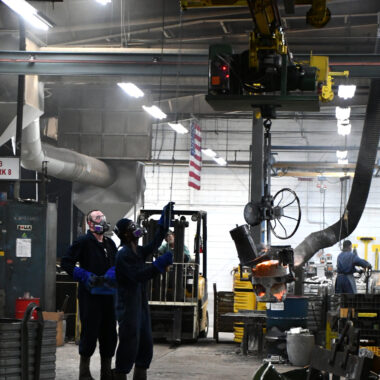Optimizing Outcomes: Casting Aluminum Like a Pro
Optimizing Outcomes: Casting Aluminum Like a Pro
Blog Article
Light Weight Aluminum Spreading Services Unveiled: Important Insights and Tips
Checking out the realm of aluminum spreading solutions can reveal a world of elaborate processes and nuanced considerations that are critical for successful results. As industries increasingly transform to aluminum for its light-weight yet sturdy properties, understanding the basics of casting becomes vital. From the essential strategies to the elaborate details that can make or damage a casting job, there is a wealth of insights and suggestions waiting to be discovered. So, as we venture right into the realm of light weight aluminum casting solutions, prepare to discover the crucial elements that can shape the trajectory of your tasks and raise your understanding of this elaborate craft.
The Basics of Light Weight Aluminum Spreading
What essential procedures are entailed in light weight aluminum casting that form the foundation of this extensively utilized manufacturing technique? Aluminum casting is a versatile and cost-efficient method utilized in various industries to develop complex and intricate steel elements. The procedure begins with the melting of light weight aluminum ingots in a heater, normally at temperature levels ranging from 1220 ° F to 1670 ° F, relying on the particular aluminum alloy being utilized. Once molten, the light weight aluminum is put right into a pre-designed mold and mildew tooth cavity, where it takes the form and strengthens of the mold.
After solidification, the mold is removed, and the spreading undergoes completing procedures such as warmth surface, therapy, and machining layer to meet the required requirements. Understanding these essential processes is vital for achieving top notch light weight aluminum spreadings with mechanical residential or commercial properties and accurate measurements.
Different Casting Techniques Discussed
Discovering the various techniques utilized in aluminum spreading offers important understandings into the diverse approaches made use of to achieve specific and intricate metal elements. One typical method is sand spreading, where a mold and mildew is produced utilizing compressed sand around a pattern of the desired component. An additional technique, die casting, includes infusing liquified aluminum into a steel mold and mildew under high pressure.
Variables to Consider When Choosing a Supplier
When choosing a light weight aluminum casting service provider, assessing their experience and experience is crucial for ensuring top quality and reliability in the manufacturing procedure. The copyright's experience in the field indicates their experience with different spreading methods, prospective obstacles, and finest practices. It is necessary to ask about the kinds of jobs they have functioned on in the past, guaranteeing they straighten with the complexity and specifications of your very own project.
Furthermore, consider the company's online reputation within the industry. Try to find testimonials, endorsements, and study that demonstrate their ability to deliver top notch light weight aluminum castings continually. A respectable company will typically have certifications or associations with industry organizations, showcasing their dedication to quality and adherence to industry criteria.
Moreover, examine the company's abilities in regards to customization, quantity demands, and project timelines. Make sure that they can suit your specific needs and have the adaptability to range production as called for. Efficient communication and transparency relating to costs, preparation, and quality assurance procedures are also crucial factors to think about when choosing an aluminum casting provider.

Usual Difficulties and Solutions
Navigating with the intricacies of Continued light weight aluminum spreading procedures frequently presents manufacturers with a series of challenges that need navigate to this website innovative options to ensure performance and quality in production. One typical challenge dealt with in light weight aluminum casting is the development of defects such as porosity, contraction, or inclusions because of inappropriate mold and mildew design or insufficient metal high quality. These flaws can endanger the architectural stability of the end product. To address this, producers ought to perform extensive simulations and tests to enhance the casting procedure parameters and make sure the top quality of the molds and products used.
Implementing sophisticated technologies like computer-aided layout (CAD) and computer system numerical control (CNC) machining can improve accuracy and uniformity in light weight aluminum casting. By spending in automation and real-time tracking systems, makers can improve process control and lessen variants, eventually improving the overall top quality of aluminum actors items.
Tips for Optimizing Your Spreading Projects
By guaranteeing that the gating system is well-designed and appropriately placed, you can enhance the circulation of liquified aluminum and lower the chances of flaws in the last casting. In addition, utilizing computer simulations can aid in examining the circulation and anticipating of steel during the spreading process, permitting for adjustments to be made before real manufacturing begins.

Verdict
In final thought, understanding the basics of aluminum spreading, different casting techniques, variables to take into consideration when selecting a copyright, typical challenges and options, and ideas for enhancing spreading jobs are vital for successful results. By sticking to these insights and executing finest practices, people and businesses can ensure efficient and reliable light weight aluminum spreading services that fulfill their particular demands and needs.
Comprehending these basic procedures is vital for achieving top quality aluminum spreadings with precise measurements and mechanical homes.
When picking a light weight aluminum casting solution copyright, assessing their experience and experience is essential for guaranteeing top quality and dependability in the production procedure. Reliable interaction and transparency relating to expenses, lead times, and quality control processes are also essential factors to think about when picking a light weight aluminum casting solution provider.
Browsing through the intricacies of light weight aluminum spreading processes frequently offers producers with a collection of difficulties that require innovative solutions to guarantee performance and quality in manufacturing. One usual challenge dealt with in aluminum spreading is the development of defects such as porosity, shrinking, or inclusions due to improper mold and mildew layout or insufficient metal top quality.
Report this page